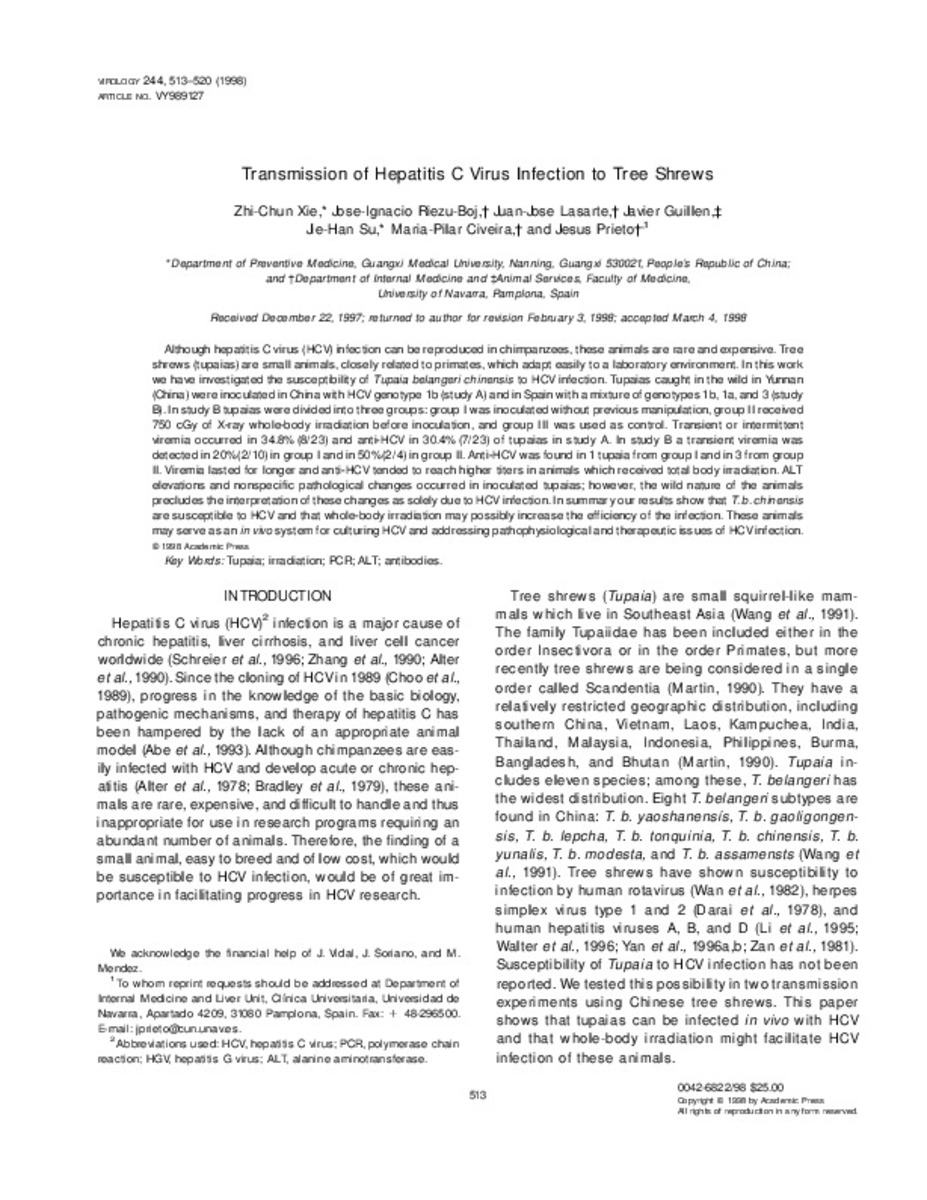Full metadata record
| DC Field | Value | Language |
|---|---|---|
| dc.creator | Xie, Z.C. (Zhi-Chun) | - |
| dc.creator | Riezu-Boj, J.I. (José Ignacio) | - |
| dc.creator | Lasarte, J.J. (Juan José) | - |
| dc.creator | Guillen, J. (Javier) | - |
| dc.creator | Su, J.H. (Jie-Han) | - |
| dc.creator | Civeira, M.P. (María Pilar) | - |
| dc.creator | Prieto, J. (Jesús) | - |
| dc.date.accessioned | 2012-04-23T07:40:31Z | - |
| dc.date.available | 2012-04-23T07:40:31Z | - |
| dc.date.issued | 1998 | - |
| dc.identifier.citation | Xie ZC, Riezu-Boj JI, Lasarte JJ, Guillen J, Su JH, Civeira MP, et al. Transmission of hepatitis C virus infection to tree shrews. Virology 1998 May 10;244(2):513-520. | es_ES |
| dc.identifier.issn | 1096-0341 | - |
| dc.identifier.uri | https://hdl.handle.net/10171/21718 | - |
| dc.description.abstract | Although hepatitis C virus (HCV) infection can be reproduced in chimpanzees, these animals are rare and expensive. Tree shrews (tupaias) are small animals, closely related to primates, which adapt easily to a laboratory environment. In this work we have investigated the susceptibility of Tupaia belangeri chinensis to HCV infection. Tupaias caught in the wild in Yunnan (China) were inoculated in China with HCV genotype 1b (study A) and in Spain with a mixture of genotypes 1b, 1a, and 3 (study B). In study B tupaias were divided into three groups: group I was inoculated without previous manipulation, group II received 750 cGy of X-ray whole-body irradiation before inoculation, and group III was used as control. Transient or intermittent viremia occurred in 34.8% (8/23) and anti-HCV in 30.4% (7/23) of tupaias in study A. In study B a transient viremia was detected in 20% (2/10) in group I and in 50% (2/4) in group II. Anti-HCV was found in 1 tupaia from group I and in 3 from group II: Viremia lasted for longer and anti-HCV tended to reach higher titers in animals which received total body irradiation. ALT elevations and nonspecific pathological changes occurred in inoculated tupaias; however, the wild nature of the animals precludes the interpretation of these changes as solely due to HCV infection. In summary our results show that T.b. chinensis are susceptible to HCV and that whole-body irradiation may possibly increase the efficiency of the infection. These animals may serve as an in vivo system for culturing HCV and addressing pathophysiological and therapeutic issues of HCV infection. | es_ES |
| dc.language.iso | eng | es_ES |
| dc.publisher | Elsevier | es_ES |
| dc.rights | info:eu-repo/semantics/openAccess | es_ES |
| dc.subject | Tupaia | es_ES |
| dc.subject | Irradiation; | es_ES |
| dc.subject | PCR | es_ES |
| dc.subject | ALT | es_ES |
| dc.subject | Antibodies | es_ES |
| dc.title | Transmission of hepatitis C virus infection to tree shrews | es_ES |
| dc.type | info:eu-repo/semantics/article | es_ES |
| dc.relation.publisherversion | http://www.sciencedirect.com/science/article/pii/S0042682298991279 | es_ES |
| dc.type.driver | info:eu-repo/semantics/article | es_ES |
Files in This Item:
Statistics and impact
Items in Dadun are protected by copyright, with all rights reserved, unless otherwise indicated.






